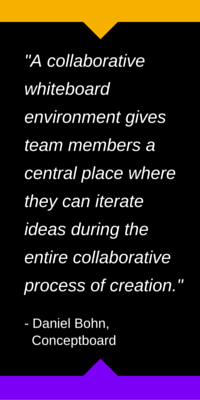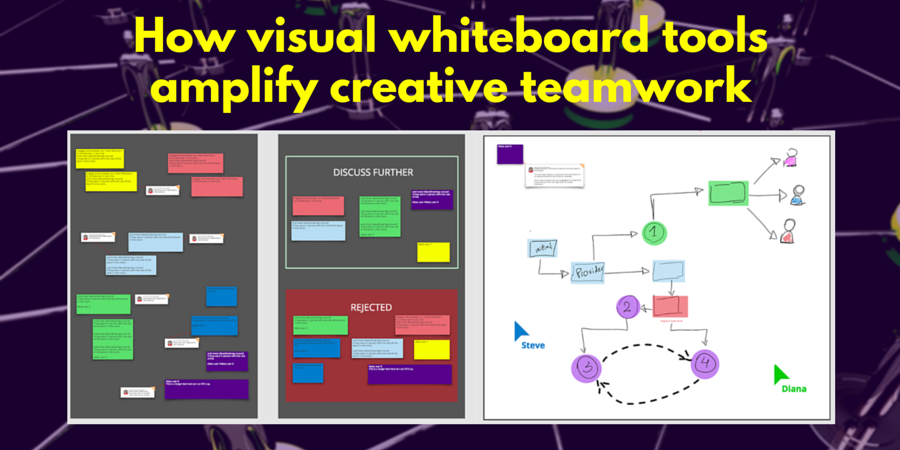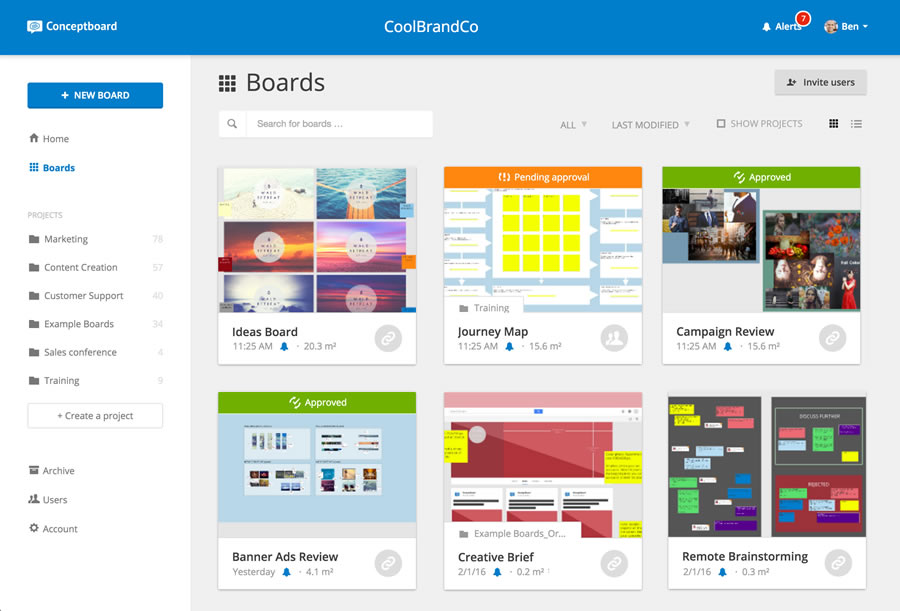Collaborative whiteboard tools enable teams to share ideas, concepts and inspirations visually. That enables them to reach consensus faster, iterate and improve ideas and even assign tasks to begin project implementation.
They are a unique animal, much different than popular enterprise collaboration tools like WebEx and GoToMeeting. To help you better understand what collaborative whiteboard tools are and how they can help teams be more productive and creative, I recently interviewed Daniel Bohn, the founder and CEO of ConceptBoard. He shared some brilliant insights about their unique capabilities and advantages.
Frey: How does a collaborative, web-based environment like ConceptBoard help creative teams work together more effectively?
Bohn: Our mission is to help users of ConceptBoard to get their ideas across more clearly, using visuals. Teams can create mood boards consisting of images they’ve collected, rough drawings or wireframes, and then discuss these raw materials while looking them at the same time. That’s very powerful!
It’s especially useful during kickoff meetings for brand campaigns. There are so many elements the team must consider. You can easily create multiple collections of visuals, each devoted to a different part of the project. They can upload big “hero” images, with smaller, more detailed images beneath it. They can also share examples and sketches that give the other team members a very clear idea of the project’s proposed creative direction. They’re also quite useful for getting stakeholder support, once again because they communicate the essence of a creative project so concisely and compellingly.
The boards enable teams to group and organize ideas and discuss them in an orderly way that a multi-page written brief just can’t accomplish. One customer actually compares their whiteboards to “visual briefs,” because they can convey so much more information and context than a written brief ever could.
Frey: That’s awesome! I love the concept of the “visual brief.”
Bohn: Yes, It’s a very elegant way to explain what the whiteboard provides to creative teams.
Frey: How does a whiteboard tool like this differ from the type of collaboration most executives are familiar with, provided by tools like GoToMeeting and WebEx?
 Bohn: You might say that whiteboard tools like ConceptBoard are the “missing link” of collaboration that those enterprise conferencing tools haven’t addressed.
Bohn: You might say that whiteboard tools like ConceptBoard are the “missing link” of collaboration that those enterprise conferencing tools haven’t addressed.
Tools like GoToMeeting and WebEx are designed to share a file, discuss it and mark it up – but with an actual meeting in mind. In other words, a group of people sitting virtually together, going through a presentation, sharing a document or having a discussion, and after a certain time everyone leaves again to their work. It’s very transient.
Do you see the limits of this? They need to find a time that fits everyone’s schedule. For globally-dispersed teams, that can be challenging. There’s no opportunity to access the data after the meeting, to continue the discussion in a shared, online environment or to document the team’s thinking process, the decisions reached and tasks assigned.
By focusing on the content, a whiteboard-centered tool can offer a place for continuous exchange: before the meeting, in the meeting and afterwards. Especially when they provide some sort of project management functionality, like notifications and tasks, and thereby help accelerate the decision-making process.
A collaborative whiteboard environment gives team members a central place where they can iterate ideas during the entire collaborative process of creation. That’s very powerful!
Frey: What do your customers tell you are the biggest benefits of this visual collaboration process?
Bohn: The biggest is time savings. By having everyone viewing the same set of visuals, teams can come to consensus and make decisions faster. One customer told me their teams are able to work 30% faster on creative projects!
Visuals also enhance the quality of the discussions, by enabling them to have all of the content and the discussion in one place. You’re not separating the content from the discussion, which is often the case with other forms of long-distance collaboration.
Frey: Does ConceptBoard support both asynchronous and synchronous collaboration?
Bohn: Of course. For teams where members can’t be online at the same time (asynchronous), they can easily add comments to individual elements in a board. Or they can add new visuals and notes that inspire them. The next time everyone logs in, they see an updated set of visual resources and comments to think about and discuss.
Comments are particularly important, whether teams are working synchronously or asynchronously. On the one hand, that’s because they can be used to add context to images, and to document the visual language the team intends to convey. On the other hand, with @mentions and task assignments, they trigger notifications for other users and build a bridge to enable task management for the project.
For those teams who are able to be online at the same time (synchronously), we gave the board complete real-time capabilities. Participants always see live who is doing what on their boards. Plus, the boards are supplemented by a live conferencing system where participants can use video chat or do guided moderations; in other words, they can walk the other participants through the content, explaining their thinking as they refer to specific visual elements in the workspace.
Frey: How, specifically, does ConceptBoard enable team brainstorming?
Bohn: First of all there are colored sticky notes, which team members can use to submit their ideas. Colors can be used to indicate the decisions the team has made about each idea, such as those that are worthy of further discussion and those they have rejected. You can set a time limit on the brainstorms.
Some customers also create sections on the boards where each participant can post their ideas. Each participant fills their section, with sticky notes but also with sketches and visual examples they insert from their computers and the web.
Here’s something really unique: You can conduct multiple “rounds” of brainstorming. In other words, round one is a free-for-all. Everyone can submit as many ideas as they want, no matter how far-fetched.
At the end of that first idea “sprint,” the team decides which ideas are worthy of further discussion. They can be grouped together and either moved to a different section of the whiteboard’s canvas or transferred to another board for round two, which is where the group builds upon these promising ideas, further enhancing them and adding any new ideas they suggest.
Round 3 is a further refinement, and is usually where teams begin building action plans for the ideas they have decided to implement.
It’s a very efficient process!




Leave a Reply